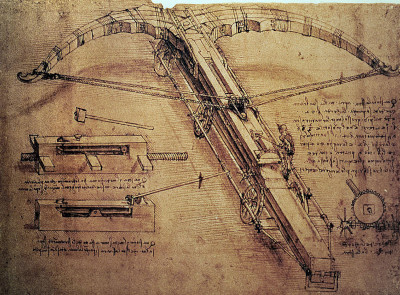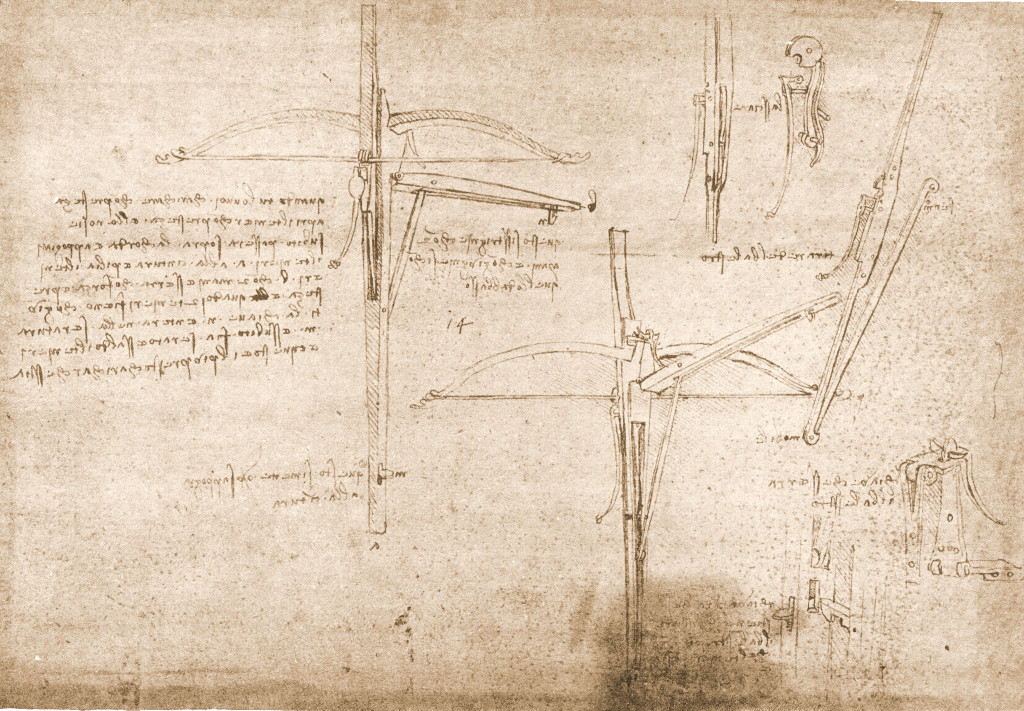Leonardo's Giant Crossbow is one of the more memorable inventions from his time as an engineer. The drawings included here are loosely dated between the 1480s and 1490s.
Introduction
During the time of Leonardo da Vinci Italy was a fractured, unstable region. War was common, making military engineering a particularly valuable discipline. It was hoped that Leonardo would be able to combine his inventive mind with his background as an engineer to give his side the competitive advantage on the battlefield.
Ludovico Sforza was an important employer of Da Vinci and also served as Duke of Milan from 1494 to 1499. He was a patron of the arts, but was also intent of strengthening the region's position, through force if necessary. Da Vinci would write to him, offering new ideas for military inventions, keen to get support for his work.
Whilst many of Leonardo's inventions were never put into practice, modern engineers have studied them in detail and found considerable merit in many of his ideas. In most cases, his innovations were simply too far ahead of what was feasible at the time, but if combined with modern materials and production techniques, many could have been effective.
These particular drawings are contained within the Codex Atlanticus, which is a large selection of drawings and notes from his lifetime which have been bound together. A number of other codexs exist from his career, but none are as large or historically significant as this one. Many of his most famous inventions can be found within this publication.
In documenting the full life cycle of his inventions, we have been able to better understand the precise, scientific practices that he followed. Much thought around physics and design would go into his inventions, and he would also proactively search for potential issues, in order to give his ideas the best chance possible.
Leonardo's relationship with Ludovico Sforza would become amongst the most important in his career. The resources that he was afforded allowed him to work on all manner of different projects, some of which were not even connected to his work for the Italian Prince.
This article examines Leonardo da Vinci's crossbow designs in detail, placing them into context within his work as a military engineer. We discuss whether these designs would likely have worked in a real-world context, and how Da Vinci's innovations would inspire engineers in later centuries.
Table of Contents
- Introduction
- Rapid Fire Crossbow
- Giant Crossbow
- Modern Analysis and Testing of Da Vinci's Crossbows
- What is the Codex Atlanticus?
- References
Rapid Fire Crossbow
Whilst the Giant Crossbow was intended to intimidate an opposition, the Rapid Fire Crossbow was all about taking out whole infantries with short bursts. Leonardo would have worked on both designs at around the same time, seeking the acceptance of Sforza.
It may well have been that Leonardo saw potential issues with the size of his larger crossbow, and so produced this alternative follow-up design, with both probably being completed in around 1488–1489.
This version was more complicated, using a series of pulleys and hinges to generate the frequent firing action. Visually, it does not look as strongly built as the alternative giant crossbow, and may well have run into problems if used in battle with this design.
The inner workings of this crossbow are demonstrated in the extract from the Codex Atlanticus below, with the artist adding notes alongside many of his drawings to help explain how they were intended to work. Some of these ideas were sent directly to Ludovico Sforza to seek approval for their production.
Giant Crossbow
The considerable power generated by the increased size of Da Vinci's Giant Crossbow would allow missiles to be delivered with greater force, and potentially a number of heavier items to be used instead. It may have been intended to throw large boulders, even bombs, through the air, potentially causing mass destruction against the enemy.
Da Vinci essentially deconstructed existing crossbows and worked on a larger scale, tackling each element one at a time. This should have made the design more reliable, but issues still existed with something on this grand scale. The range would also have been considerably larger than any opponent, offering a threat to any approaching armies.
Leonardo's inventions are very much a case of "what if". Many of his ideas have been proven to have had a sound scientific basis to them, but struggled because of the lack of certain materials and technologies during Renaissance Italy, which have since become available.
The design includes a soldier preparing the machine, as shown below. This allows us to get a better idea of the extraordinary scale of the design, meaning a large team would have been needed to move and operate the crossbow, as well as some engineers to maintain the complex setup.
Modern Analysis and Testing of Da Vinci's Crossbows
A number of models and prototypes of Da Vinci's crossbow designs have been produced in recent years, including for a museum dedicated to the artist's legacy. A British TV programme brought many of his inventions to life, and found success with his giant crossbow.
An alternative project, run by a number of skilled engineers, also brought his crossbow to life and managed to do so with just one tweak, a strengthening of its bow, which they had determined was necessary to achieve a functioning weapon.
What is the Codex Atlanticus?
Both crossbow designs are featured in the Codex Atlanticus, from pages 143 to 155. This codex is a publication of hundreds of drawings and notes produced by Leonardo da Vinci from 1478 – 1519. Besides military weaponry, there are also many other genres within here, such as botany studies and also a number of mathematical research projects.
Da Vinci is most famous for his paintings, such as Mona Lisa and The Last Supper, but there continues to be interest in his work in other disciplines, particularly his engineering innovations. With his reputation remaining strong today, enthusiasts continue to bring them to life for their own amusement as well as a sign of respect for what Leonardo achieved all those years ago.
References
- Leonardo. The Complete Paintings and Drawings, Frank Zöllner & Johannes Nathan, Taschen
- Leonardo da Vinci, Walter Isaacson





